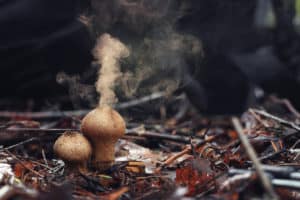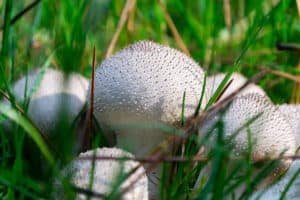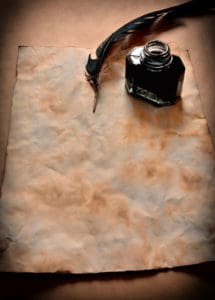Puffball mushrooms are a unique species of the fungus family. You might have even come across one of these in at least once in your lifetime and probably missed it. They’re easily found in grassy fields so you might want to look out for them the next time you’re gathering mushrooms or just wanting to have an adventure.
For this reason, here’s a guide on puffball mushrooms that will tell you all you need to know about them for your next mushroom hunting expedition.

What are Puffball Mushrooms?
Puffball mushrooms are a type of fungus that includes several species within the family including Calvatia, Lycoperdon, and Bovista to name a few.
These species are called ‘puffball mushrooms’ due to their tendency to release spores in the air if one of the mature ones is physically interacted with.
A fully grown puffball mushroom has an uncountable number of spores, even up to seven trillion for the giant puffball mushroom.
The release of a large number of spores in the form of a cloud of dust is how this mushroom gets its name.
The most common species amongst this family are the giant puffball mushrooms (Calvatia gigantea) that are found in many parts of the world and widely available in Europe and North America.
What Do Puffball Mushrooms Look Like?
Puffball mushrooms are solid white on the exterior as well as the interior. The uniqueness of these mushrooms come from the fact that they have no gills, stem, or mushroom cap, unlike other common edible mushrooms. They are completely solid spheres of white, ranging from the size of a small cherry tomato to as big as a football.
Puffball mushrooms are easy to identify since they’re large, white, and round, making them easily distinguishable if you’re exploring around and happen to bump into one. Their insides are also solid white, with a soft spongey texture to it.
Is it Safe to Eat Puffball Mushrooms?
Puffball mushrooms are completely safe to consume. This means that if you have a true puffball mushroom on hand and can easily distinguish it, you’ve got the green light to bring them home and enjoy them in a meal.
The first thing to look out for is to stay clear from puffball mushroom lookalikes, mainly the mushrooms from the Amanita family that causes severe symptoms even leading up to death and have no known cure.
Secondly, to get your hands on a puffball mushroom that is edible and delicious, you need to look for young puffball mushrooms instead of mature ones since mature ones are not deadly but can result in a stomach ache or even food poisoning.
To get the right puffball mushroom, without falling into the trap of a poisonous lookalike or mature mushroom, look at the exterior first.
Ensure your puffball mushroom is fully white without any coloration due to the fact that mature mushrooms start developing a yellowish greenish color on the outer surface.
Additionally, once you’re done inspecting the exterior and are fully satisfied, cut open the mushroom from the middle and look for a thick white texture. If you see any brown spots or any other indications, leave it be.
A tip to getting delicious edible puffball mushrooms is that if you find a mature one, kick or step on it to release its pores which will get you the young puffball mushrooms you need in a few days.

Where do Puffball Mushrooms Grow?
Puffball mushrooms mainly need a grassy area to grow, meaning that they can easily grow in any grassy field such as meadows, fields, even forests.
One of the main benefits of the growth of puffball mushrooms is that since they release their spores in the air, a wide range of the surrounding area will bring new puffball mushrooms, unlike other mushrooms that can only grow in a limited area.
The growth of puffball mushrooms happens between late summer and early fall that lies in the late August to October period. You can make the best of this season by exploring grassy fields around your location for this unique ingredient to your meals. And the best part is that since they grow on grounds on a large area, you won’t even have to actively look for them each time but can instead go to that same area in a few days again to find a new batch of puffball mushrooms!
How to Store Puffball Mushrooms?
The thing about puffball mushrooms is that even though they’re easy to find and distinguish, they’re still unique since it’s hard to find this delicacy in your local general stores and/or mushroom farms. Therefore, the best way to go about is to grab a bunch if you find them and store them with an effective method.
Puffball mushrooms can go bad if you don’t eat them while they’re fresh or extend their shelf life. For this reason, if you’ve grabbed more than you need for your next meal, chill them in the fridge or freezer and take them out according to whenever you want to eat them. It’s preferable to store them in a cool place whole i.e. without cutting them up, but if you’re short on space you can easily cut them into slices or pieces and then store them up to a few weeks.

Fun Fact- Traditional Usage as Ink
This might come as an interesting fact, historically puffball mushrooms have been used as ink in Tibet. This was done through a method where the body of the mushroom was burned, and the remaining ashes were then added to water to create ink.
Benefits of Puffball Mushrooms
Puffball mushrooms have a wide range of benefits from enhancing the culinary experience to medicinal uses. Here’s a list of a few of the advantages of puffball mushrooms:
-
Delicacy to Cooking-
Puffball mushrooms have a mild, earthy flavor to them. This means that they’re not too strong in flavor and can simultaneously enhance the flavor of your dish with a mild yet delicious taste. Hence, you can add them to soups, lasagna, gravies, etc. by frying, grilling, or baking them.
-
Anti-Tumor Properties-
Puffball mushrooms are one of the primary mushrooms that are currently being studied to develop anti-cancer medicine due to the possibility that they cater to the anti-tumor possibility that can help decrease or possibly even eliminate the growth of cancer cells in the body.
-
Treatments for Bleeding and Infections-
These mushrooms have also been used in traditional medicine to stop bleeding and cure infections, either by making use of them as a powder added to medicines or as thin slices to cover wounds.
Conclusion
Puffball mushrooms are a unique species that spreads its own spores, provides various uses in medicine, and is a food ingredient you need to try if you haven’t yet.
Next time you go on a mushroom hunting expedition, or you’re looking to grow your own mushrooms and what to go for an option that’s uncommon, puffball mushrooms can give you the adventure and taste you need to add in your life due to the reason that it can be added to a wide range of food delicacies and will complement it perfectly! Just make sure you don’t fall for its poisonous doppelganger.




